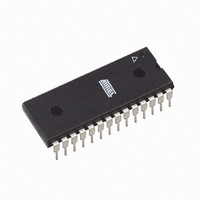ATMEGA8-16PC Atmel, ATMEGA8-16PC Datasheet - Page 59

ATMEGA8-16PC
Manufacturer Part Number
ATMEGA8-16PC
Description
IC AVR MCU 8K 16MHZ COM 28-DIP
Manufacturer
Atmel
Series
AVR® ATmegar
Specifications of ATMEGA8-16PC
Core Processor
AVR
Core Size
8-Bit
Speed
16MHz
Connectivity
I²C, SPI, UART/USART
Peripherals
Brown-out Detect/Reset, POR, PWM, WDT
Number Of I /o
23
Program Memory Size
8KB (4K x 16)
Program Memory Type
FLASH
Eeprom Size
512 x 8
Ram Size
1K x 8
Voltage - Supply (vcc/vdd)
4.5 V ~ 5.5 V
Data Converters
A/D 6x10b
Oscillator Type
Internal
Operating Temperature
0°C ~ 70°C
Package / Case
28-DIP (0.300", 7.62mm)
Lead Free Status / RoHS Status
Contains lead / RoHS non-compliant
Other names
ATMEGA816PC
- Current page: 59 of 302
- Download datasheet (6Mb)
ATmega8(L)
• SCK – Port B, Bit 5
SCK: Master Clock output, Slave Clock input pin for SPI channel. When the SPI is enabled as a
Slave, this pin is configured as an input regardless of the setting of DDB5. When the SPI is
enabled as a Master, the data direction of this pin is controlled by DDB5. When the pin is forced
by the SPI to be an input, the pull-up can still be controlled by the PORTB5 bit.
• MISO – Port B, Bit 4
MISO: Master Data input, Slave Data output pin for SPI channel. When the SPI is enabled as a
Master, this pin is configured as an input regardless of the setting of DDB4. When the SPI is
enabled as a Slave, the data direction of this pin is controlled by DDB4. When the pin is forced
by the SPI to be an input, the pull-up can still be controlled by the PORTB4 bit.
• MOSI/OC2 – Port B, Bit 3
MOSI: SPI Master Data output, Slave Data input for SPI channel. When the SPI is enabled as a
Slave, this pin is configured as an input regardless of the setting of DDB3. When the SPI is
enabled as a Master, the data direction of this pin is controlled by DDB3. When the pin is forced
by the SPI to be an input, the pull-up can still be controlled by the PORTB3 bit.
OC2, Output Compare Match Output: The PB3 pin can serve as an external output for the
Timer/Counter2 Compare Match. The PB3 pin has to be configured as an output (DDB3 set
(one)) to serve this function. The OC2 pin is also the output pin for the PWM mode timer
function.
• SS/OC1B – Port B, Bit 2
SS: Slave Select input. When the SPI is enabled as a Slave, this pin is configured as an input
regardless of the setting of DDB2. As a Slave, the SPI is activated when this pin is driven low.
When the SPI is enabled as a Master, the data direction of this pin is controlled by DDB2. When
the pin is forced by the SPI to be an input, the pull-up can still be controlled by the PORTB2 bit.
OC1B, Output Compare Match output: The PB2 pin can serve as an external output for the
Timer/Counter1 Compare Match B. The PB2 pin has to be configured as an output (DDB2 set
(one)) to serve this function. The OC1B pin is also the output pin for the PWM mode timer
function.
• OC1A – Port B, Bit 1
OC1A, Output Compare Match output: The PB1 pin can serve as an external output for the
Timer/Counter1 Compare Match A. The PB1 pin has to be configured as an output (DDB1 set
(one)) to serve this function. The OC1A pin is also the output pin for the PWM mode timer
function.
• ICP1 – Port B, Bit 0
ICP1 – Input Capture Pin: The PB0 pin can act as an Input Capture Pin for Timer/Counter1.
Table 23 on page 60
and
Table 24 on page 60
relate the alternate functions of Port B to the
overriding signals shown in
Figure 25 on page
56. SPI MSTR INPUT and SPI SLAVE OUTPUT
constitute the MISO signal, while MOSI is divided into SPI MSTR OUTPUT and SPI SLAVE
INPUT.
59
2486Z–AVR–02/11
Related parts for ATMEGA8-16PC
Image
Part Number
Description
Manufacturer
Datasheet
Request
R

Part Number:
Description:
IC AVR MCU 8K 16MHZ 5V 32TQFP
Manufacturer:
Atmel
Datasheet:

Part Number:
Description:
IC AVR MCU 8K 16MHZ 5V 32-QFN
Manufacturer:
Atmel
Datasheet:

Part Number:
Description:
IC AVR MCU 8K 16MHZ 5V 28DIP
Manufacturer:
Atmel
Datasheet:

Part Number:
Description:
IC AVR MCU 8K 16MHZ COM 32-TQFP
Manufacturer:
Atmel
Datasheet:

Part Number:
Description:
IC AVR MCU 8K 16MHZ IND 32-TQFP
Manufacturer:
Atmel
Datasheet:

Part Number:
Description:
IC AVR MCU 8K 16MHZ IND 28-DIP
Manufacturer:
Atmel
Datasheet:

Part Number:
Description:
IC AVR MCU 8K 16MHZ COM 32-QFN
Manufacturer:
Atmel
Datasheet:

Part Number:
Description:
MCU AVR 8KB FLASH 16MHZ 32QFN
Manufacturer:
Atmel
Datasheet:

Part Number:
Description:
IC AVR MCU 8K 16MHZ IND 32-QFN
Manufacturer:
Atmel
Datasheet:

Part Number:
Description:
IC MCU AVR 8K 5V 16MHZ 32-TQFP
Manufacturer:
Atmel
Datasheet:

Part Number:
Description:
IC MCU AVR 8K 5V 16MHZ 32-QFN
Manufacturer:
Atmel
Datasheet:

Part Number:
Description:
IC MCU AVR 8K 5V 16MHZ 28-DIP
Manufacturer:
Atmel
Datasheet:

Part Number:
Description:
IC MCU AVR 8K 16MHZ 5V 32TQFP
Manufacturer:
Atmel
Datasheet:











